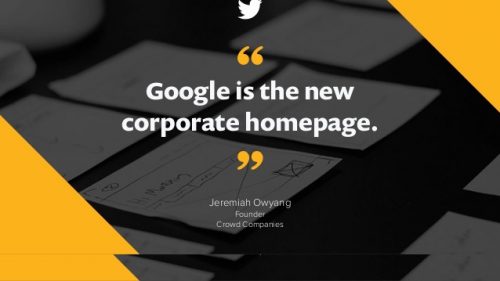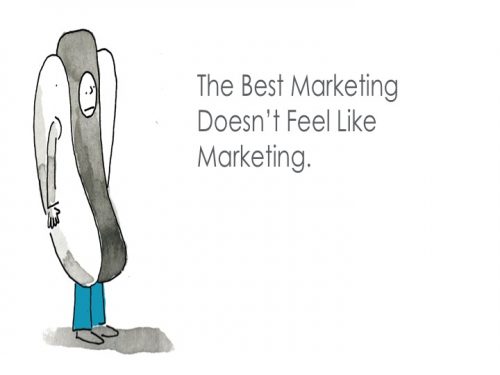Image Credit: Pierrick Barfety
“Content is King.” (Bill Gates)
“Content isn’t king, it’s the kingdom.” (Lee Odden)
“Content is king, but distribution is queen; and she wears the pants.” (Jonathan Perelman)
“Content Marketing is a commitment, not a campaign.” (Jon Buscall)
*****
There’s certainly no shortage of adages, slogans, or idioms about content marketing, why it’s the bee’s knees, and why your business should be doing it. And while some are embellished, and others are seeped in snake-oil or kool aid, many still are right on point and worth heeding lest.

The truth is that if you’re not investing in content, then you’re not investing in your business’s infrastructure.
The thing about infrastructure is that it’s the foundation on which you build your business. It’s the foundation on which you hang your business’s growth, the framework that supports it. And when it comes to content marketing, we’re talking about the foundation of nearly all your other marketing — i.e. every way you communicate with your customers, leads, and the public at large.
Content is Everything
Content isn’t just that occasional blog post or Facebook update you produce in your intern’s free time. It’s everything your brand produces to engage with and communicate to its audience — web copy, landing pages, videos, product descriptions, and so on. And all of that content represents an opportunity to convey your brand’s message about itself and/or its products (e.g. their value proposition, unique selling proposition, or whatever else you feel makes them special or stand-out from other players).

The thing about any piece of content, though, is that it’s either on message or it’s not.
Indeed, what separates a piece of content from just another mundane marketing asset is that it conveys, supports, or extends your brand’s messaging — instead of just relating information about your products or services. And when you think about content in those terms, it’s easy enough to see how it extends to every last part of your marketing infrastructure.
Content is SEO
Whether you drink the koolaid or not, I can’t state enough just how much content is really f**king important for SEO. It allows you to (1) bolster a site’s relevance across targeted keyword verticals, (2) attract quality backlinks from relevant and authoritative sites, and (3) speak directly to users who already want to buy your products or services.

Think about it: SEO is intentional targeting because organic search users are actively searching for the kinds of solutions you can offer them. The very fact that they’re typing their needs into a search box means that they’re already one step down the conversion funnel.
More importantly, it’s impossible to compete in the SERPs without credible and relevant content. Content is the essence of what Google (and other search engines) indexes when it crawls a web page and determine its keyword relevance. So if you have relevant content, you can rank it; and if you can rank it, you can convert the users who are already looking for it.
Content is PPC / SEM
Of course, the thing with SEO is that it’s a medium- to long-term strategy. Simply put, it takes time to build trust/authority on any given set of keywords and rank on them organically. If you’re willing to pay for each click, though, you can jump the queue using PPC.

From the ad copy that appears in the SERPs to the landing pages users click-through to, good content is what drive PPC/SEM campaigns. Bidding on keywords gives you the same intentional targeting as SEO, but compelling ad copy that speaks to users generates clicks, and engaging landing pages drive conversions. Indeed, Adwords campaigns backed by strong content experience better click-through-rates, improved Quality Score, and lower Avg. CPCs than generic broad match campaigns.
Content is Display & Media Buys
While we’re on the topic of paying-to-play, let’s address a common fallacy people have about the difference between paid media and earned media — namely that they’re at opposite ends of the spectrum.

Yes, earned media is ‘good content’ that allows you to position yourself in front of targeted users without paying for every impression and click. But, a paid media campaign built around a strong content strategy generates better click-through-rates and higher conversions than one based on a more conventional spray-and-pray display campaign.
Essentially, if your banner ads (1) appear alongside/within relevant 3rd party content, and (2) speak directly to a specific need that (3) your landing pages fulfill, you can expect your CPA to drop.
Content is Social Media
No channel is as intertwined with content as social media. After all, social media is about interaction, and short of having romantic relationship or Tinder date with its customers, the most effective way that brands can interact with consumers is through content.

Think about it: from the links your brand share to its status updates to the details on its profile pages, every touchpoint between a brand and its customers on social media occurs through content. Sponsored content, paid content, multimedia content; it’s all content, and it defines the basis of every interaction your brand has with consumers.
Consequently, your brand can’t really invest in social without investing in content itself. Trying to tackle social media as a channel in any other way ends up being nothing more than a glorified ‘socialized’ banner ad campaign.
Content is Drip Marketing
It’s great to engage users who are engaging your brand on social media. But what about the ones who came into the store to check things out, or maybe even bought something small, but never came back?
Well, content is essential to reminding them that you still care and you can still fill their needs.
Drip marketing is based on the premise of on nurturing relationships with consumers by sending them pre-set messages over time over a certain period of time. And, sure, you can try sending them promos and seasonal discounts.

But if you want them to open your emails and actually engage with them, then you have to show that you understand them. And nothing quite shows someone that you understand them quite like showing them that (1) you not only understand their problems or challenges, but (2) you have a solution to that problem.
Value-added content does just that. And by working it into your drip marketing campaigns, you’ll be able to nurture relationships that convert instead of just throwing money at email blasts about seasonal discounts or special promos.
Content is Lead Generation
Of course, before you can even start nurturing leads or prospects, you have to find them. And solid, value-added content is one of the most effective ways of targeting and qualifying the right kinds of leads and prospects.
Once you’ve invested in value-added content that addresses your customers’ needs, you can package or repurpose it as ebook, white paper, or some other kind of download. And once you do that, you can promote across social media and other paid channels (such as PPC and display) that allow you to target users by relevant criteria, and offer it as a free download in exchange for little more than a name and an email.
Now you not only have something that your prospective customers are interested in, but the names and coordinates of users who actually engaged with it. The rest is up to your sales (and maybe drip marketing) team.
Content is Sales
Speaking of sales, too often is it looked at as that more aggressive, hands-on channel that’s driven by interpersonal communication and suggestion rather than hard assets. Ask any seasoned sales rep, though, and they’ll tell you that they’re only as effective as the tools they have access to. And no sales toolbox is quite complete without proper content-based assets.

From sales brochures to product landing pages, content plays an important role in the sales process. It whets the customer’s appetites, and urges them to pick up the phone or walk into a store and speak with a member of your sales team. And if that content relates to their situation and speaks to their needs, it’s significantly more likely to whet said appetite so that when they do engage a member of your sales team, they’re already one step further down the sale funnel.
Content is Customer Service
Of course, many customer interactions only begin with an initial purchase. Whether you’re hawking consumer products or B2B services, many of your customers are going to require ongoing service and support.
From product FAQs to support forums, content plays a big role in the customer service experience your brand offers. These content assets allow users to troubleshoot many of their own challenges, or failing that, better communicate their needs when they do contact your team for assistance. The result is that fewer customer support tickets need to be created, and those that are, are more easily resolved.
Content is the Conclusion
In case you haven’t noticed,content is kinda a big deal. And not just from the perspective of a koolaid-drunk snake-oil salesman, but from the perspective of the big picture.
Investing in content isn’t just about investing in specific channels. It’s about investing in your business’s infrastructure — your very brand, its messaging, and every step of your conversion and retention funnels. Indeed, content is something special, something that reaches and extends into every part of your business.
In fact, how’s this for a bad metaphor? Content is like an octopus: you can invest in only a few selective tentacles, or you can invest in the entire animal, and let it watch as it defies the odds of your expectations.
The point is that if you really want to disrupt or capture more of your market, then you’re going to have to invest in content, because you’re gonna need the kind of infrastructure that truly sets you aside from the competition — i.e. offers consumers some special and of value — and can support your business’s ongoing growth.